Most of you have figured out that I keep waffling between loving one frame, loving stitching in hand, loving the Q-snap, loving the Lowery. Then there was the chair situation. The swivel recliner wasn’t working with Oscar sitting with me and wiggling because that made the chair wiggle . . and Oscar wiggles a lot! Every time the chair wiggled, my needle went into the wrong hole. I’m pretty much liking the loveseat. I’d better . . if I tell Vince I want to try something else, it probably isn’t going to be good!
Over the past couple of weeks, I’ve had to try to make some decisions about my frames and stands and, just in case there’s anyone here struggling with the same thing, maybe this will help and maybe it will give you some ideas about what to consider if you’re still on the fence about a stand and frames.
There are way more stands/frames than I’m going to mention. These are the ones I’ve used. Vonna Pfeiffer, who is the most amazing stitcher/finisher, and knows more about all aspects of stitching and finishing than I will ever know, has some great reviews of stands/frames here.
Stitching in Hand:
This is my favorite way to stitch but because of hand pain, I don’t think I’ll ever be able to do this again. The other day I had maybe an hour’s worth of stitching to do and thought I could do it in hand but after about 10 minutes, my hand was aching and I had to stop. I’ve tried exercises, a brace, and I’m afraid any more stitching in hand is just making matters worse.
The Lowery Stand:
For at least a year, the Lowery stand has been the frame I’ve used most for several reasons. As of today, the cost at Love Crafts is about $212.00.
The Lowery stand isn’t working so well with the new love seat because the love seat has wide, thick arms and that puts the stand too far away, thereby making the “arm” too short for having the frame where I need it to be, even with the extended bar for the arm. I did try clamping the Lowery onto the roller (vs. the side) and I can’t get an angle that’s comfortable for the way I like to stitch.
Pros:
- It works with most any frame, Q-snap or hoop.
- It can easily be repositioned.
- When I was sitting in the recliner, the stand was sitting to my right side so it wasn’t out in front of me or in the chair with me.
- The length of the bar can be adjusted so if you’re working on the far right side of the frame and the stand is on your right side, you can extend it out so you’re not right against the frame. Likewise, as you move to the left of the frame, you can slide the bar to your right so the piece is more in front of you.
- It is portable. The two bars (one that raises and lowers the stand and one that move your frame to the left or right) can either go almost completely into the stand or they can be removed and carried separately.
- It hardly takes up any room!
Cons:
- It isn’t terribly stable, especially with a long frame. I placed a 10 pound bag of sugar on the base and that kept it stable but also meant if I wanted to move the frame, I had to get up, move the bag of sugar, reposition the frame, add the bag of sugar back.
- It can be positioned in front of you if you’re sitting in a chair, but the most secure way to hold the frame is totally horizontal. If you like to stitch with your frame/piece tilted, the frame wasn’t very secure.
The Rolaframe:
The frames and stands are made by one man with a little help from his family. While I do appreciate that, it’s also a problem in that it is almost impossible to get frames. On the other hand, if I would occasionally finish something, I wouldn’t need so many frames. Yes, I could remove one piece and put on another piece but, for me, once it’s on a frame, it’s staying til it’s finished.

When I first started stitching, I bought a small Rolaframe floor stand. It will hold an 8″ to 28″ roller set, which means you would probably want to use it for a piece of linen no wider than about 26″. The very first piece I was working on was larger than that so I learned that I could order a new “bar” that fits across the back and that would turn my small stand into a large stand, and fit rollers 18″ to 38″. An 18″ floor stand is $150 and a 28″ floor stand is $185.
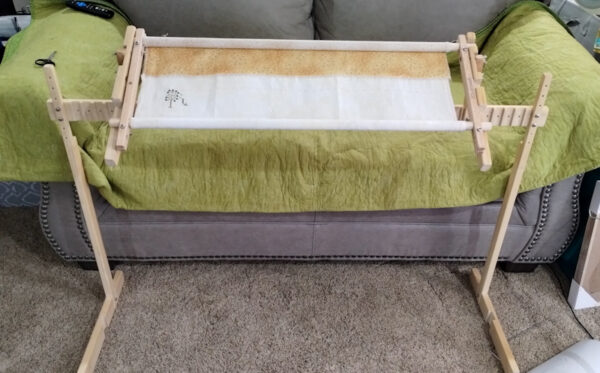
Above is the large Rolaframe floor stand. You can see that it pretty much is the same width as the loveseat. No matter what size frame I’m using, the stands are going to always be the same lengh as that back bar – doesn’t matter if I’m using a 38″ frame or an 18″ frame. The legs are screwed onto the back bar so there’s no way to make that whole setup any narrower. Same with the lap stand. Currently the small floor frame is $185 and the large floor frame is $195 at A Stitch in Time. I’ve ordered from them many times and have always had good service and fast shipping.
Pros:
- Well built and easy to adjust to fit the frame size I need.
- Holds the linen quite securely – as tight as you want to make and keep it. (see photo of nails below)
- Easy to flip the frame up to see the back of your work or to clip a thread.
- There are height adjustments on both the floor and lap stands. If you like your work right up under your nose, you can almost get it there. If you want it almost on your lap, you can almost get it there.
Cons:
- The stand only works with Rolaframe frames. Without a doubt, someone is going to say they made theirs work with other frames. I’m sure it CAN be done but it isn’t easy and the frame and stand work quite well together as a set.
- It does not come with the roller bars or the end set and you must have those in order to use it. For a 30″ roller set and a 13″ end bar, that’s an additional $75.
- Without taking the whole thing apart, it isn’t very portable.
- They take up a bit of space and the only way to reduce their footprint is to take them apart.
- There aren’t many positions for adjusting the angle of stitching.
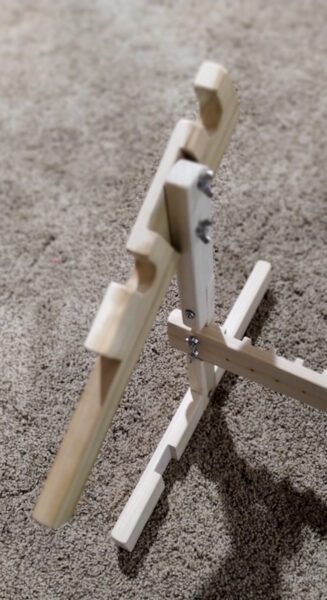
While you can use the different size frames on both the floor stand and the lap stand, in order to go from one size frame to other, the piece shown above (the vertical part that holds the rollers) that I will call the “arm” has to be unscrewed (one wing nut) and moved to a different position. The photo above is the lap stand. The photo above this one is the floor stand and in that photo, you can see the “slots” on the back bar for positioning the correct frame size.
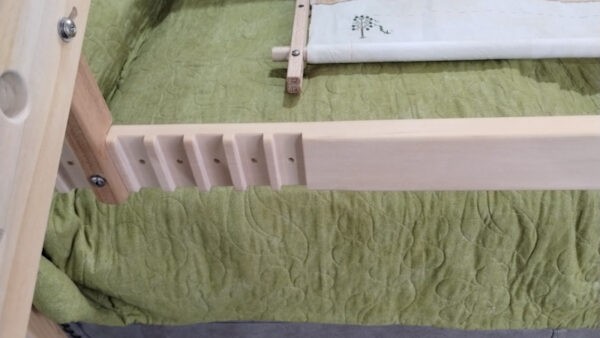
Above you can see a closer view of those slots. Say I had been using a frame and this was the correct position but the next frame I wanted to use was 2″ narrower. I could either remove the “arm” on the left and right sides, move each side in one slot (1″ per slot) or you could simply remove one side and move it over two slots. The frame would not be centered on the stand but that generally doesn’t matter to me.
Here is a photo of the lap stand currently loaded with Rejoice Evermore.
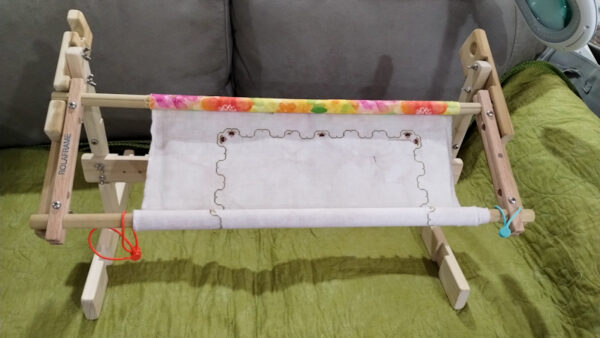
One thing with the Rolaframe frames is neither a pro or a con but yet, both! Figure that one out. The dowels are split lengthwise. One side has tiny, super sharp nails and the fabric is attached to the nails. The other side has holes corresponding to the nails so the side with holes fits over the side with nails and once rolled, the fabric isn’t going anywhere. I have to be so careful that I don’t load my fabric where the cat or the dog may end up on those nails. There have been several times that I found myself bleeding. They are super sharp.
To reduce the risk of injury, you could put a piece of cotton fabric onto the nails and leave it, then pin or baste your linen to the cotton fabric so that once the cotton fabric is on the nails, it never has to come off.
The K-Stand:
I like this stand and the more I use it, the more I like it. It doesn’t seem as “refined” as the Rolaframe but it does the job and in the end, isn’t that what matters. It does have several features I love. There used to be an adapter that would allow the K-Stand to accommodate a Q-Snap or stretcher bars. I’m not seeing that on the Etsy page but if you’re interested, you may want to contact them and check on it.
I order the K-Stands and accessories from Bee Creek, Ltd. on Etsy. Currently, on Etsy, their large lap frame is $87 and it holds pieces 22″ to 36″ AND it comes with the 28″ scroll frame. You can get them with different size frames – larger frames add a bit more to the cost.
This is the large and it has Three Things Sampler on it.
The standard size frame (shown below) is now $78 and will accommodate a 13″ frame up to a 22″ frame.
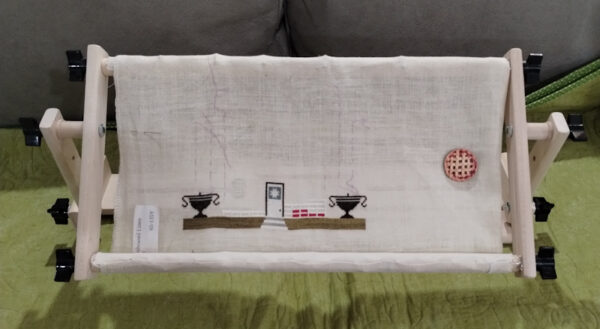
The photo above makes me laugh. This is one of the first pieces I started. I do not like the linen. It’s a very low count and I’m using two strands of floss and I do not like that. I am going to take it out of the frame and I doubt I’ll ever finish it. I know it’s been in the frame for over two years.
They also have other stands – floor stands, metal stands, rook hooking stands, stretcher bars, etc. I have the two shown above so those are all I am able to review.
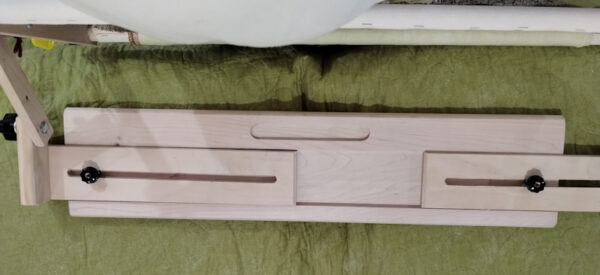
Above is their base. You can see where the “arms” are and the piece I have attached. In order to accommodate a smaller or larger frame, the knobs at the bottom are simply unscrewed and the pieces slide out to make it wider or in to make it more narrow. You can see that my frame isn’t centered on the stand. That’s an example of where I needed it larger or smaller and simply loosened one knob and moved it in or out to accommodate my frame.

One of the best features is that it folds down flat. This is the best of the frames I’ve used when it comes to traveling with it. I have a lightweight blanket that I throw over my legs while stitching if it’s chilly in the basement. You’ve probably seen Oscar snoozing on it. Just in case you haven’t . .

OK . . back on topic. I wrap the stand and frame in that little blanket, put it in a king size pillowcase and stick it in the car and it travels just fine.
Pros:
- Fairly inexpensive compared to other stands/frames.
- Easiest of the frames I have to adjust for other sizes.
- When I’m sitting on the sofa or loveseat, I can move the frame across my lap instead of having to move myself to a different position.
- Easiest of the frames I have to adjust the angle of the stitching.
- Folds flat when not in use or for traveling.
- The plastic knobs are much easier for turning than using metal wing nuts (I think that’s what they’re called).
Cons:
- A piece of canvas is stapled to the dowel rod. It’s very narrow. I wish it was wider. I now machine baste a piece of cotton fabric to the top and bottom of all my linen when I’m fixing to use it. I pin that cotton fabric to the canvas. I could sew a wider piece of cotton fabric to the canvas and leave it on there but then I would also have to sew a piece of cotton fabric to the linen or pin the linen to the cotton that’s attached to the canvas. This isn’t a huge problem but I wish the piece of canvas was wider.
As a sidenote, here you can order three frames, 22″, 24″ and 26″ for $124. With that package, you get the two roller bars in each length, three pairs of 10″ side bars and 12 of the plastic knobs for turning. Bars in the same size and end pieces in the same size, from Rolaframe, would be over $200. Shipping is currently free at Bee Creek, Ltd. on Etsy.
Just my thoughts and my opinions. The prices I’ve stated are the current prices online. These may change (and probably will) so always check the prices before ordering.

